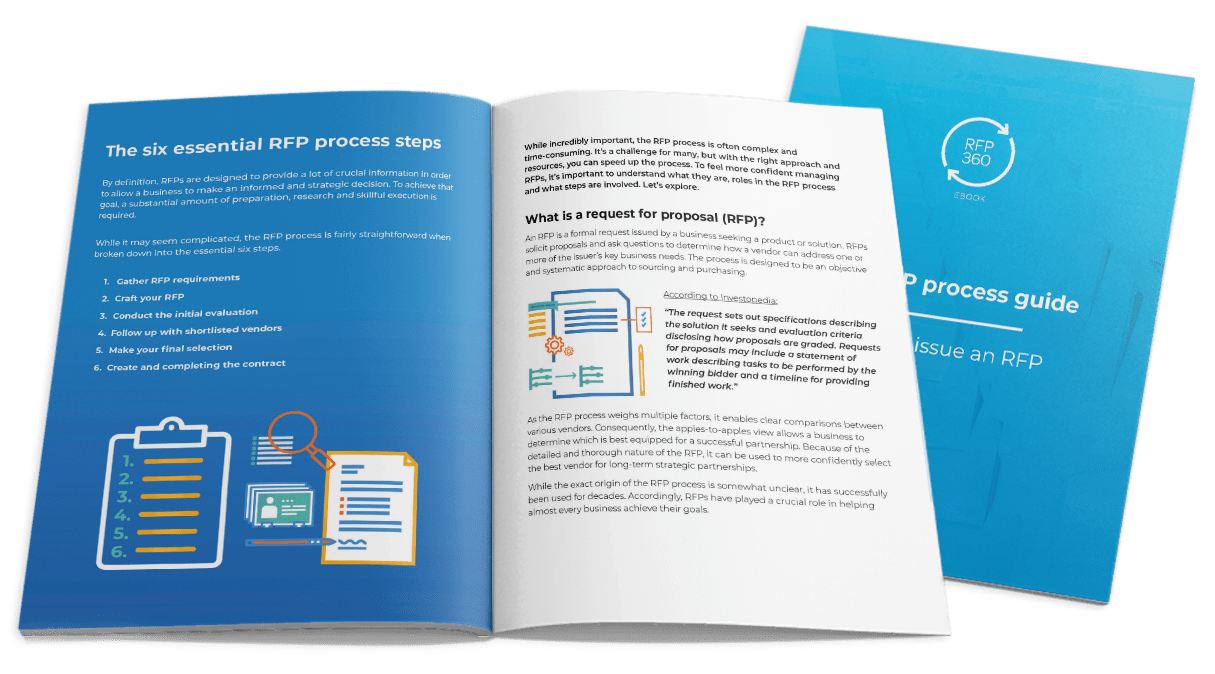We all know the frustration of trying to get an uncooperative printer to work. Between running out of ink and toner, endless treasure hunts to find the source of a paper jam and trying to interpret indecipherable error codes, it can be maddening. Luckily, when you’re ready for an easier solution, you don’t have to run a copier RFP or printer RFP. Instead, issue a managed print services RFP.
Managed print services (MPS) providers offer a one-stop-shop solution for everything printer, copier and toner related — saving time, money and your sanity. As business printing strategies become more challenging in light of remote, hybrid and return to work trends, bringing in an expert to navigate your investment is a good idea. Fortunately, our friends at the Managed Print Services Association (MPSA) offer an abundance of resources for MPS providers as well as businesses seeking services.
In this post, we’ll share advice from print services experts and RFP experts. First, we’ll outline the benefits of issuing an RFP as well as a how-to guide that walks through the process. Then, we’ll offer a selection of questions to consider when writing your RFP. Finally, we’ll explore some tips to get the most out of your RFP process.
- What are managed print services?
- 3 benefits of issuing an RFP for managed print services
- How to issue a managed print services RFP
- Quick tips for success
What are managed print services?
According to Gartner, managed print services, often referred to as MPS, “are services offered by an external provider to optimize or manage a company’s document output. The main components provided are needs assessment, selective or general replacement of hardware, and the service, parts and supplies needed to operate the new and/or existing hardware (including existing third-party equipment if this is required by the customer). The provider also tracks how the printer, fax, copier and MFP fleet is being used, the problems, and the user’s satisfaction.”
The goal of engaging a managed print services provider is to reduce costs associated with business printing, copying and scanning including equipment maintenance, IT support, service and labor.
What is a managed print services RFP?
A managed print services request for proposal (RFP) is a document created and issued by an organization to gather and compare provider information about products and services before making a purchase.
3 benefits of issuing an RFP for managed print services
So, you may wonder why you would use an RFP to select a managed print services provider. The request for proposal process is designed to make selecting the right vendor clear and easy. In addition, companies that use an RFP enjoy several other benefits.
1. Customized proposals and easy comparisons
Your company has unique printing needs. Accordingly, your proposal should be highly customized. Rather than having different companies provide information in their own style, focusing only on their best features, an RFP levels the playing field. Indeed, it provides a structured and standardized format that makes side-by-side comparisons easy and reduces bias.
2. Secure competitive rates
When you issue an RFP, it signals to MPS providers that they should come to the table with their best offer. In addition, the RFP provides context and background helps vendors focus on what matters most to your organization. With the additional information, they’ll be able to offer highly-tailored solutions that will best serve your business.
3. Reduced risk
RFPs are thorough. They cover everything from customer reviews to data security practices. By using an RFP, you ensure that your vendors are properly vetted and your decision process is well documented. Afterall, the last thing you want is to sign a high-value, multi-year contract only to later realize that the provider can’t integrate with your network or provide a key service.
How to issue a managed print services RFP
If you’ve managed other RFPs before, you’ll know that the RFP process can be broken down into three key steps — RFP creation, administration and evaluation.
To explore the the RFP process in more detail, download this ebook: The RFP process guide.

Creation
The first step of the RFP process is crucial. Often, the success or failure of your procurement project can be traced to the research that goes into RFP creation. To start, you’ll need to do a little research.
- Interview stakeholders and end-users to identify your needs. What equipment and services do you need? Which factors are deal breakers?
- Investigate your current state. Who is your current provider? What’s working, and what needs improvement?
- Explore the market. Are there new services or solutions available? What has changed since your last contract?
Sections to include in your RFP
Now, it’s time to write your RFP. Use the information you’ve gathered to customize each section in your RFP. To start, you’ll share your company information, project scope and goals. In addition, include information about the process so vendors can plan appropriately. Finally, you’ll start writing your RFP questions.
- RFP summary and background information
- Scope and project goals
- Evaluation criteria and submission instructions
- RFP timeline
- RFP questions
- Terms and additional documentation
Sample MPS RFP questions
Admittedly, starting from scratch when writing RFP questions is intimidating, and it’s hard to know what to ask. Fortunately, the members of MPSA are RFP experts.
Drawing from years of experience and thousands of RFPs, MPSA compiled a list of the best MPS RFP questions. Here you’ll find a sampling of the questions. But, if you’re issuing a managed print services RFP, you can register for a free MPSA membership and access the full template here.
Supplier information questions
- Describe the scope and depth of your MPS program.
- Explain your organization’s infrastructure to support your MPS program.
- What metrics do you use to measure growth, efficiencies or cost savings to improve the customer’s organization?
Equipment requirements
- Describe your firm’s approach to equipment and consumable sustainability.
- What are your installation / removal and disposal processes?
- Are you an OEM or a dealer? Which OEMs are your partners and why?
Toner/Ink fulfillment
- Describe the supply fulfillment process.
- Explain how you will manage supply usage and supply inventory.
- How will the software allow automated fulfillment based on alerts and triggers?
Break/Fix requirements
- Explain process and options used to manage reactive break/fix service issues.
- How do you proactively identify potential break/fix issues?
- List all of the break/fix service related reporting used and provided for your solution.
Security and solutions
- Please detail how your company uses technology to optimize managed print services.
- Explain how you will protect the organization from security risks.
- Provide an overview of your proposed portfolio’s security model and features.
Remember, as you include these questions, consider how you can tailor each one to your needs to ensure you receive the best possible proposal from interested vendors.
Scoring
Ideally, you now have at least three great proposals from prospective service providers. Now, it’s time to review, score and compare them. First, check each proposal for compliance. Is the RFP complete? Do they meet the minimum requirements? Did they follow instructions?
Second, engage the stakeholders and end users you interviewed. Ask them to help score the RFP sections that are most relevant to them. Don’t forget to include IT, administrative staff, operations, legal, HR and any others who will be key to the success of the partnership.
Next, calculate the scores of each vendor and compare offers. Once you’ve done this, hopefully, you’ll have a clear winner. Congrats! You’ve found the right fit for your needs.
Quick tips to make the most of the RFP process
Know what you need
One of the biggest challenges for people issuing managed print services RFPs is not knowing what to ask for. After all, it’s unlikely that you’re an expert in the field. That’s why it’s so important to invest time in defining your current state and end goals.
If you’re still unsure what you need, consider issuing a request for information (RFI). An RFI is similar to an RFP. Where the RFP asks for information about a specific scope of work, the RFI shares information about your challenges and asks vendors to provide creative solutions. It’s a good way to solidify your plan as well as narrow your vendor selection for your RFP.
When you’re ready to issue a managed print services RFP, it should at a minimum include:
- Expected timeline
- Number of locations and printers required
- Number of users
- Existing printing fleet details
- Common print and copy services needed
- Document services beyond printing and copying
- Document and device security requirements
- Infrastructure compatibility requirements
- Uptime and maintenance service requirements
- Environmental sustainability requirements
- Remote work solutions
- Assessment, analytics and reporting approach
Engage stakeholders and end-users
We mentioned this above but include it again here because it’s so important. At the end of the day, real people will interact daily with the products and services you select. And, if they’re unhappy, you’re going to hear about it.
By bringing stakeholders and end-users into your process to both create the RFP requirements as well as score proposals, you’ll ensure that the vendor you select meets your most pressing needs. These users can bring a new, valuable perspective to your process and help identify any gaps in your prospective solution.
Prioritize what’s important
There will be no shortage of factors to consider, which is why it’s crucial to decide which are most important. Naturally, there will be some sections of your RFP which receive less weight than others. RFP weighted scoring provides an easy way to assign more value to the most critical sections and questions of your RFP.
For instance, details of a company’s background are always nice to know, but usually not a significant consideration. On the other hand, functionality, ease of use, customer support practices and customer references are vital. No matter what is most important to you, be sure it’s reflected in your RFP questions as well as your scoring process.
Leverage technology
The RFP process can be complex and time consuming. However, RFP management software makes it much easier. It enables you to centralize the entire process, moving it from your inbox and spreadsheets to a digital single source of truth. Additionally, RFP software empowers better collaboration with both colleagues and vendors while cutting the time it takes to issue and manage an RFP by up to 50 percent.
Ultimately, moving to managed print services can save your organization a tremendous amount of time and money. So, when it’s time to make a change, consider leveling up and letting the experts take over the tough stuff. Armed with this information and the MPS questions, you can create a well-written and thoughtful RFP that helps you quickly and confidently select the right partner.
If you have additional questions about managed print services, reach out to MPSA here. Or, if you’d like help with your RFP process, contact RFP360.

